By Frank Iannamico
The Colt Thompson
The Thompson Submachine Gun evolved from an earlier idea that was conceived by U.S. Army Ordnance officer John T. Thompson. Colonel Thompson’s original plan was to provide the United States Army with a semi-automatic service rifle. Thompson’s concept weapon was dubbed the Auto-Rifle. Thompson left the Army with the express intent of privately developing his Auto-Rifle and selling it to the army. He soon found Thomas Ryan willing to finance his endeavor, and in 1916 the Auto-Ordnance Corporation was formed.
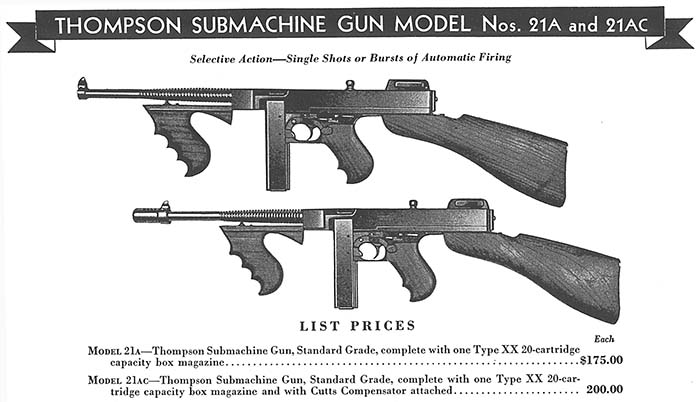
The early work on the proposed Auto-Rifle was done in Cleveland, Ohio. Thompson hired Theodore Eickoff as his chief engineer, along with Oscar Payne as a designer and a small staff to study and develop the Auto-Rifle concept. Auto-Ordnance in its early years of existence had no assets other than a small office. The Warner and Swasey Company built all of Auto-Ordnance’s early prototype weapons. John Thompson had tried to instill a strong sense of urgency in all of the employees of Auto-Ordnance. World War One was raging in Europe, and the United States would be soon entering the fray. Thompson was understandably anxious to get his weapon developed, manufactured and into the fight.

(Michael Free Collection)
When Thompson was setting the groundwork for his Auto-Rifle project, he spent considerable time searching for breach mechanisms and other inventions that might be utilized in his Auto-Rifle. That is when he found the Blish principle of metallic adhesion. A U.S. Navy officer by the name of John Blish discovered the principle. Blish had theorized that certain metals, when set at particular angles, became alternately adhesive and repellent under alternating high and low pressure. Blish had first noticed the phenomena during his tenure as a naval officer. He discovered that the breeches on large seacoast guns and those on naval vessels would remain safely closed upon using full charges, but when firing reduced or saluting charges the breechblocks (when set at a certain angle) would unlock themselves. Inspired by these observations Blish performed a number of experiments that proved the phenomenon. He patented his idea as a “breech closure device for firearms” in 1915. Thompson felt that the Blish Principle applied to a shoulder fired automatic weapon would be ideal – eliminating linkages, pistons and other complications of gas operated systems.
Thompson had placed great faith in the Blish principle and insisted that it be incorporated in the Auto-Rifle design. As Eickoff experimented with prototype Auto-Rifles he discovered that the Blish principle was simply not workable with any cartridge in the 30’06 class. The powerful 30’06 was the standard cartridge of the U.S. forces and the obvious choice for the Auto-Rifle. Eickoff had found through research that the only way the Blish principle would work with such powerful cartridges was by lubricating the cases. This of course was totally unacceptable for a military weapon. Upon further development Eickoff discovered that the .45 ACP pistol round was workable with the Blish lock. After Eickoff reluctantly reported his findings to Thompson, Eickoff was surprised when he (Thompson) almost instantly envisioned a “miniature hand held machine gun” using the proposed Blish lock principal. Soon the work at Auto-Ordnance began to focus on a .45 caliber weapon that Thompson had envisioned as a “trench broom” intended to sweep the enemy from their trenches.
The focus of the Auto-Ordnance Corporation soon shifted to the development of a .45 caliber automatic weapon that was to be named the Thompson Submachine Gun, in honor of the man who had envisioned it -John T. Thompson. After several prototypes and experimental models were built, a production model finally emerged. The very first limited production gun was the Model of 1919, of which only a few were built; this was followed by the well known and equally famous Model of 1921.
In 1921 an agreement between the Auto-Ordnance Corporation and the Colt’s Patent Fire Arms Manufacturing Company was reached. The actual manufacture of the weapon had to be subcontracted to Colt because the Auto-Ordnance Corporation, who developed the weapon, did not have any manufacturing capabilities.
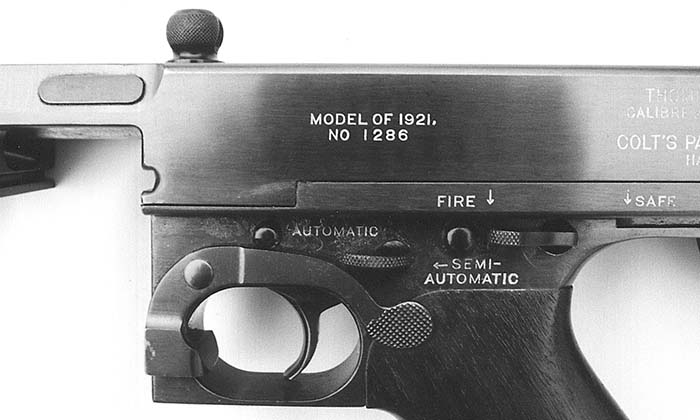
(Michael Free Collection)
The 15,000 Thompson Submachine Guns manufactured by Colt were all originally produced as the Model of 1921. The original runs of Thompson guns were manufactured to very high standards that were common of the era. The 1921 model had a very high quality lustrous blue finish. The fine walnut furniture was also of very high quality. The manufacture of the foregrips, buttstocks and a few other parts was subcontracted out to Remington. The 1921’s were equipped with a vertical foregrip, and the buttstock lacked the cross-bolt and sling swivels later seen on military stocks. The Lyman Sight Company of Connecticut was contracted to manufacture the rear sights for Auto-Ordnance. The rear sight was the ladder type and considered by many to be quite complicated for use on a rapid-fire weapon. The barrel of the Thompson featured radial cooling fins and a milled blade style front sight. No Cutts compensators were originally fitted to the guns. The actuator, fire mode selector and the safety levers were finely checkered. The machined one-piece ejector on the Colt guns was flat without rivets protruding out like the later military Thompsons. Many Colt-manufactured Thompson’s were inspected by Auto-Ordnance’s Chief Inspector John H. Barrett and have his initials JHB stamped on the receivers of the guns.
The original retail price of the 1921 model was $200.00 supplied with one type XX twenty round box magazine. The first production Colt Thompson, serial number 41, came off the assembly line in March of 1921. By this time World War I had ended and there was no demand for new weapons. Sales of the Thompson were extremely slow. It would take almost twenty years to sell all of the initial production of 15,000 guns. The $200.00 list price of the Thompson was quite a sum of money in the 1920’s.
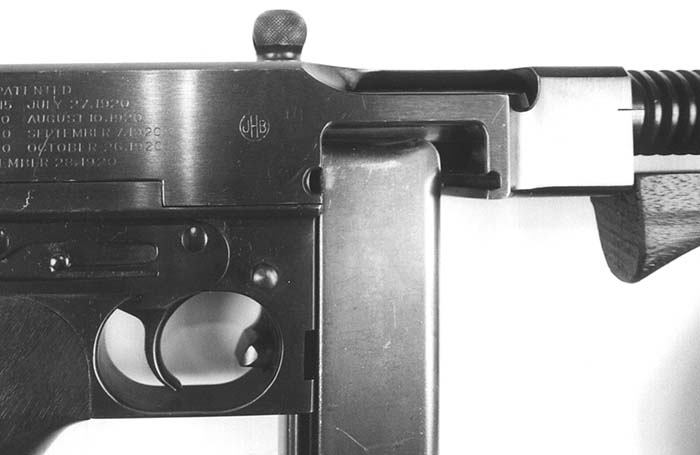
By 1923 the price was reduced to $175.00 in an attempt to attract buyers for the Thompson. Also in 1923 a “new” military model was introduced as the Model of 1923. The new model was no doubt influenced by the WWI success of the Browning Automatic Rifle, better known as the BAR. The 1923 military model was nothing more than a standard 1921 model that was refitted with a 14.5-inch barrel, a bipod and a horizontal foregrip. To increase the effective range, a new special cartridge was offered. The new .45 caliber cartridge was called the Remington-Thompson. It featured a 250-grain projectile in a longer .998-inch case. Muzzle velocity was 1,450 feet per second. The concept of the Thompson Military model was unsuccessful and few were built. The idea was abandoned shortly after it was conceived.
The 1921AC Model
Introduced in 1926, the 1921AC model was simply a standard model 1921 with a Cutts compensator fitted to the muzzle. The Cutts compensators were manufactured by the Lyman Gun Sight Company, and began being offered as an enhancement for the 1921 Thompson. The compensator was claimed to significantly reduce muzzle rise and was offered as a $25.00 option. The Thompson Gun without the optional compensator was then designated the 1921A model. There were several variations of the Cutts compensators manufactured.

The 1927 Semi-Automatic Carbine
The 1927 carbine model is one of the rarest variations of the early Colt Thompson Guns. The 1927 model like the 1921AC, was created from altering existing 1921 models. The unique feature about the 1927 was that it was a semi-automatic-only weapon. This was probably done to offer a model of the Thompson to law enforcement organizations who simply did not want to arm their officers with a submachine gun. The conversion was accomplished by redesigning a few internal parts. The full-auto markings were neatly milled out of the receiver and remarked. The 1927 model is still regarded as an NFA firearm because of its short barrel and submachine gun receiver. Model 1927 Thompsons are not often found still in their original semi-auto-only configuration, most were converted back to select fire at some point in time. The 1927 model was available with or without the optional Cutts compensator installed.
The 1928 Navy Model
The most prolific Colt-manufactured Thompson model was the 1928 Navy model also referred to by collectors as the Colt overstamp, the 1921 overstamp, 28 Navy, 28 over 21, or the 28N. The 1928 Navy model, too, was made from a standard 1921A model. It was conceived because of the U.S. Military’s desire to have the rate of automatic fire reduced from 800 rounds per minute to approximately 600 rounds per minute. This was accomplished by redesigning the actuator by adding a block of steel to it. This made the assembly four ounces heavier, and along with redesigned recoil spring and pilot rod, slowed the rate of fire to an acceptable level. The firing pin spring was also redesigned and was slightly shorter than in the 1921 model. All 1928 Navy models had the numeral 1 (in the 1921 designation) overstamped with the numeral 8 to make it read 1928. The words “U.S. Navy” were also stamped into the receiver on virtually all of the converted guns. The Navy markings were impressed into the receiver rather lightly and appear noticeably different from all the other receiver markings. Although the Colt 1928 “Navy” models were marked “U.S. Navy” few actually went to the United States Navy. It proved to be the most popular model and many “U.S. Navy” 1928s were sold to police departments and foreign governments.
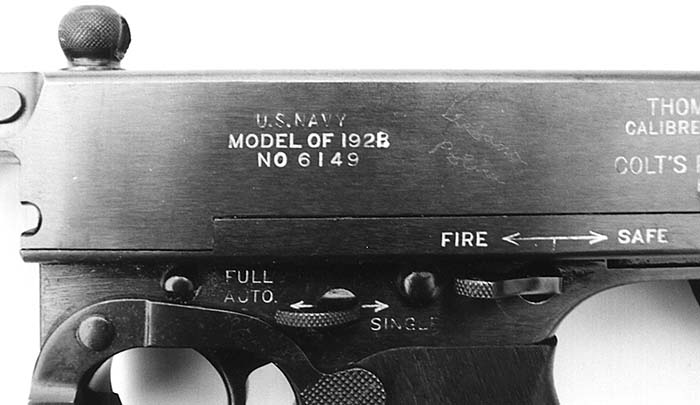
In March of 1932, the U.S. Army procured a few of the 1928 Navy Models as “Limited procurement, Gun, Submachine, Caliber .45 U.S. Navy Model of 1928”. The 1928 Thompson would be the last small arm adopted by the U.S. Army that used a year designation in the official nomenclature of the weapon. The Marine Corps expressed some interest in the Thompson Submachine Gun and procured a small number of them in the 1920s. The U.S. Marine Corps procured a total of 671 Thompson Submachine Guns from 1926 to 1928. A few of the early Thompsons received by the Marines were in the rapid firing 1921 model configuration. These were then converted to the slower firing 1928 model configuration at a cost of $8.50 per gun. These Thompsons would be used in the famous Marines exploits of the 1920s era including the actions in Nicaragua and China. The experiences with the Thompson would forever endear the weapon to the Marines who used them.
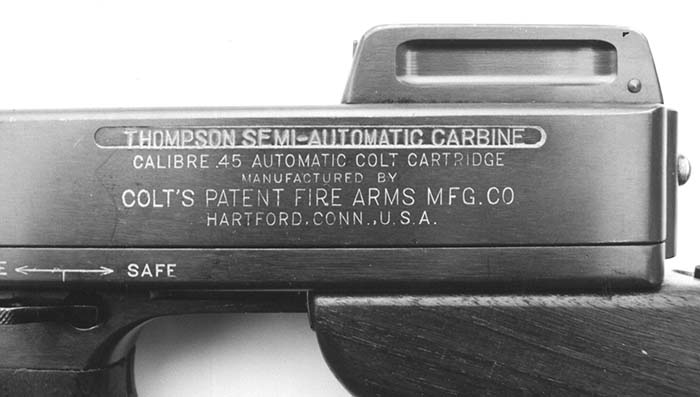
By the late 1930’s the Auto-Ordnance Corporation had fallen under the control of Russell Maguire, who would make a fortune from manufacturing and selling the Thompson during WWII. Maguire first subcontracted with the Savage Arms Company in 1939 to manufacture the weapon, and eventually Auto-Ordnance opened their own factory late in 1941 to help keep up with the demand for the gun. When Maguire began to collect all the machinery needed to begin manufacturing the WWII guns, he discovered that Colt was still manufacturing spare parts and magazines for the gun.
The Colt Thompsons today are highly sought after by diligent and usually affluent collectors. Just as in the1920’s, the Thompson remains a very expensive piece.
This article was excerpted from the book The Military Thompson Submachine Gun, available from Moose Lake Publishing LLC. 207-683-2959
| This article first appeared in Small Arms Review V5N4 (January 2002) |











